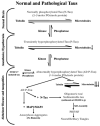Alzheimer's disease neurofibrillary degeneration: pivotal and multifactorial
- PMID: 20658985
- PMCID: PMC3092440
- DOI: 10.1042/BST0380962
Alzheimer's disease neurofibrillary degeneration: pivotal and multifactorial
Abstract
Independent of the aetiology, AD (Alzheimer's disease) neurofibrillary degeneration of abnormally hyperphosphorylated tau, a hallmark of AD and related tauopathies, is apparently required for the clinical expression of the disease and hence is a major therapeutic target for drug development. However, AD is multifactorial and heterogeneous and probably involves several different aetiopathogenic mechanisms. On the basis of CSF (cerebrospinal fluid) levels of Abeta(1-42) (where Abeta is amyloid beta-peptide), tau and ubiquitin, five different subgroups, each with its own clinical profile, have been identified. A successful development of rational therapeutic disease-modifying drugs for AD will require understanding of the different aetiopathogenic mechanisms involved and stratification of AD patients by different disease subgroups in clinical trials. We have identified a novel aetiopathogenic mechanism of AD which is initiated by the cleavage of SET, also known as inhibitor-2 (I(2)(PP2A)) of PP2A (protein phosphatase 2A) at Asn(175) into N-terminal (I(2NTF)) and C-terminal (I(2CTF)) halves and their translocation from the neuronal nucleus to the cytoplasm. AAV1 (adeno-associated virus 1)-induced expression of I(2CTF) in rat brain induces inhibition of PP2A activity, abnormal hyperphosphorylation of tau, neurodegeneration and cognitive impairment in rats. Restoration of PP2A activity by inhibition of the cleavage of I(2)(PP2A)/SET offers a promising therapeutic opportunity in AD with this aetiopathogenic mechanism.
Figures

Similar articles
-
Alzheimer neurofibrillary degeneration: significance, etiopathogenesis, therapeutics and prevention.J Cell Mol Med. 2008 Jan-Feb;12(1):38-55. doi: 10.1111/j.1582-4934.2008.00225.x. Epub 2007 Jan 9. J Cell Mol Med. 2008. PMID: 18194444 Free PMC article. Review.
-
Mechanisms of tau-induced neurodegeneration.Acta Neuropathol. 2009 Jul;118(1):53-69. doi: 10.1007/s00401-009-0486-3. Epub 2009 Jan 30. Acta Neuropathol. 2009. PMID: 19184068 Free PMC article. Review.
-
Mechanisms of neurofibrillary degeneration and the formation of neurofibrillary tangles.J Neural Transm Suppl. 1998;53:169-80. doi: 10.1007/978-3-7091-6467-9_15. J Neural Transm Suppl. 1998. PMID: 9700655 Review.
-
AMPK is abnormally activated in tangle- and pre-tangle-bearing neurons in Alzheimer's disease and other tauopathies.Acta Neuropathol. 2011 Mar;121(3):337-49. doi: 10.1007/s00401-010-0759-x. Epub 2010 Oct 19. Acta Neuropathol. 2011. PMID: 20957377 Free PMC article.
-
Abnormal hyperphosphorylation of tau: sites, regulation, and molecular mechanism of neurofibrillary degeneration.J Alzheimers Dis. 2013;33 Suppl 1:S123-39. doi: 10.3233/JAD-2012-129031. J Alzheimers Dis. 2013. PMID: 22710920 Review.
Cited by
-
Glycosaminoglycans in Neurodegenerative Diseases.Adv Exp Med Biol. 2021;1325:189-204. doi: 10.1007/978-3-030-70115-4_9. Adv Exp Med Biol. 2021. PMID: 34495536 Review.
-
Protein phosphatase 2A as a therapeutic target in inflammation and neurodegeneration.Pharmacol Ther. 2019 Sep;201:181-201. doi: 10.1016/j.pharmthera.2019.05.016. Epub 2019 Jun 1. Pharmacol Ther. 2019. PMID: 31158394 Free PMC article. Review.
-
Synapses, Microglia, and Lipids in Alzheimer's Disease.Front Neurosci. 2022 Jan 12;15:778822. doi: 10.3389/fnins.2021.778822. eCollection 2021. Front Neurosci. 2022. PMID: 35095394 Free PMC article. Review.
-
Ethnopharmacological Profile, Phytochemistry and Therapeutic Potential of Aegle marmelos L. for the Treatment of Neurological Disorders.J Nutr Metab. 2025 Jun 11;2025:2275526. doi: 10.1155/jnme/2275526. eCollection 2025. J Nutr Metab. 2025. PMID: 40535825 Free PMC article. Review.
-
Vanda roxburghii chloroform extract as a potential source of polyphenols with antioxidant and cholinesterase inhibitory activities: identification of a strong phenolic antioxidant.BMC Complement Altern Med. 2015 Jun 23;15:195. doi: 10.1186/s12906-015-0728-y. BMC Complement Altern Med. 2015. PMID: 26100408 Free PMC article.
References
-
- Glenner GG, Wong CW. Alzheimer's disease: initial report of the purification and characterization of a novel cerebrovascular amyloid protein. Biochem Biophys Res Commun. 1984;120:885–890. - PubMed
-
- Grundke-Iqbal I, Iqbal K, Quinlan M, Tung YC, Zaidi MS, Wisniewski HM. Microtubule-associated protein tau: a component of Alzheimer paired helical filaments. J Biol Chem. 1986;261:6084–6089. - PubMed
Publication types
MeSH terms
Substances
Grants and funding
LinkOut - more resources
Full Text Sources
Medical

